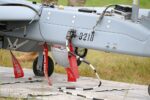The U.S. Space Force is accelerating efforts to protect its growing constellation of satellites from cyber threats by developing new tools that can detect malicious activity targeting space-based command-and-control (C2) systems. With adversaries increasingly capable of targeting satellites through electromagnetic and cyber means, the service is investing in proactive detection capabilities to secure its orbital infrastructure.
Growing Cyber Threats in the Orbital Domain
As military reliance on space-based assets intensifies—ranging from communications and navigation to missile warning and ISR—the vulnerability of these systems to cyber intrusion has become a strategic concern. Unlike traditional kinetic threats such as anti-satellite (ASAT) weapons or jamming, cyberattacks can be stealthy, persistent, and difficult to attribute.
Adversaries like China and Russia have demonstrated advanced electronic warfare (EW) capabilities that include GNSS spoofing, uplink signal interference, and potential access to satellite ground stations. These tactics can compromise satellite telemetry data or even seize control of spacecraft subsystems if not properly defended.
“Cyberattacks against satellites are no longer hypothetical,” said Lt. Gen. Stephen Whiting of U.S. Space Operations Command during a recent symposium. “We must treat every C2 link as a potential attack vector.”
Space Force’s Cyber Defense Strategy for Space Assets
The Space Force’s approach focuses on integrating cybersecurity into the entire lifecycle of space systems—from design through deployment—rather than treating it as an afterthought. This includes hardening both onboard software and terrestrial ground infrastructure against unauthorized access or manipulation.
A key element of this strategy is the development of specialized tools capable of detecting anomalous behavior across satellite networks. According to Col. Roy Rockwell, senior materiel leader for Cryptologic and Cyber Systems at Space Systems Command (SSC), these tools aim to identify indicators of compromise (IOCs) in real-time by monitoring telemetry data streams for deviations from expected operational patterns.
This effort aligns with broader Department of Defense initiatives under Zero Trust Architecture (ZTA), which assumes network breaches are inevitable and emphasizes continuous authentication and behavioral analytics over perimeter defense alone.
Leveraging AI/ML for Anomaly Detection in Orbit
To meet the unique demands of space-based cybersecurity—where latency is high and bandwidth limited—the Space Force is turning to artificial intelligence (AI) and machine learning (ML). These technologies enable automated threat detection by analyzing large volumes of telemetry data from multiple satellites simultaneously.
- Anomaly detection algorithms: ML models are trained on normal spacecraft behavior profiles to flag deviations that may indicate malware execution or unauthorized commands.
- Behavioral baselining: Satellites exhibit predictable patterns in power usage, attitude control inputs, signal timing, etc., which serve as baselines for identifying suspicious changes.
- Distributed monitoring: Data fusion across constellations allows detection tools to correlate anomalies across multiple nodes—helpful in identifying coordinated attacks or lateral movement between assets.
This AI-driven approach also supports predictive threat hunting by identifying precursors to attacks before they impact mission-critical functions such as GPS timing accuracy or secure communications relays.
Pilot Programs Underway at Space Systems Command
The initial development work is being led by SSC’s Cryptologic and Cyber Systems division based at Joint Base San Antonio-Lackland in Texas. The team has launched several pilot programs aimed at validating detection algorithms using simulated attack scenarios against testbed satellite architectures.
One such pilot involves emulating known adversary TTPs—including spoofed command uplinks or packet injection into ground station networks—and assessing how well prototype detectors can identify them without generating excessive false positives.
The goal is not only technical validation but also ensuring interoperability with existing Mission Control Systems (MCS) used across DoD space platforms such as AEHF communications satellites or SBIRS early warning systems.
Operational Integration Challenges Remain
Despite promising early results, several challenges remain before these tools can be fielded operationally:
- Data standardization: Many legacy satellites use proprietary telemetry formats that complicate cross-platform analysis unless normalized first.
- Spectrum awareness: Differentiating between benign RF anomalies (e.g., solar flares) versus malicious interference remains difficult without contextual awareness engines onboard or on-ground processing nodes.
- Crew training: Satellite operators must be trained not only in orbital mechanics but also in interpreting cyber threat indicators—a new skillset within military space operations units like Delta-6 (responsible for cyberspace operations).
- Spoof-resilient protocols: Secure command authentication schemes must evolve beyond static keys toward quantum-resistant encryption or time-bound ephemeral credentials where feasible.
A Broader Push Toward Resilient Space Architectures
The cyber defense initiative complements broader shifts within U.S. military space doctrine toward resilient architectures that assume contested environments. This includes proliferated low Earth orbit (LEO) constellations like those under the SDA’s Transport Layer program—which inherently reduce single points of failure—and modular payload designs that allow rapid reconstitution after compromise.
The National Security Strategy for Space Operations emphasizes the need for “cyber survivability by design,” echoing lessons learned from terrestrial networks where reactive patching often lags behind evolving threats. In this context, the ability to detect intrusions early becomes a force multiplier—enabling incident response teams to isolate affected nodes before cascading effects degrade mission performance.
Outlook: From Detection Toward Active Defense
If successful, these detection tools may evolve into active defense mechanisms capable of autonomously isolating compromised subsystems aboard satellites—or triggering fail-safe modes until human operators assess the situation. However, this raises complex questions around autonomy thresholds in critical national security assets operating far beyond Earth’s atmosphere.
The U.S. Space Force has not disclosed specific timelines for operational deployment but expects initial capability demonstrations within FY2025–FY2026 under existing R&D funding lines tied to SSC’s Defensive Cyber Operations-Space portfolio. Future budget cycles may expand funding depending on test outcomes and integration feasibility with joint C4ISR frameworks like JADC2.









